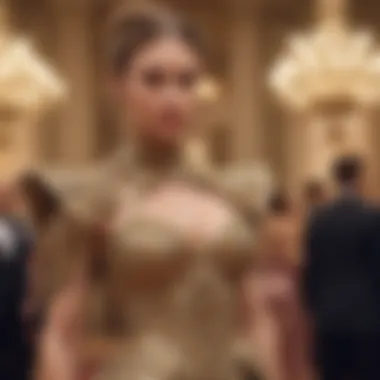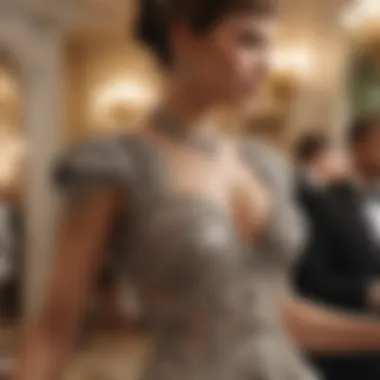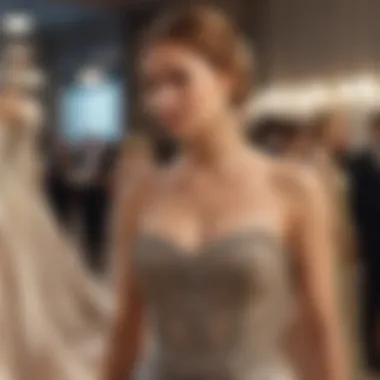Met Gala Dresses for Sale: Fashion's Elite Market Insights


Intro
The Met Gala, a prominent event in the fashion world, showcases extravagant dresses designed by prestigious designers. This annual fundraising gala for the Metropolitan Museum of Art's Costume Institute captivates fashion enthusiasts and serves as a stage for high-profile celebrities to make bold statements through their clothing. The allure of Met Gala dresses extends beyond the event itself; it manifests in a unique resale market that is gaining considerable attention.
Fashion collections from the Met Gala are not just temporary glamour; they epitomize an intersection of art and commerce. Pieces worn by notable public figures could easily turn into investments, reflecting trends and societal values.
Trending Topics
Current Fashion Trends
The fashion landscape has shifted significantly with regard to Met Gala attire. Current trends often showcase a blend of classic styles with modern touches. Designers like Alexander McQueen and Gucci continue to inspire creativity. Bright colors, structured silhouettes, and unexpected elements such as oversized accessories dominate the streets as much as they did on the red carpet.
Social media platforms like Instagram and TikTok play a crucial role in shaping these trends. Influencers and celebrities wield significant power in determining consumer preferences. The designs seen at the Met Gala quickly become reference points for designers worldwide, influencing what is available in the retail market.
Beauty Innovations
Alongside the dresses, beauty trends accompany them. Makeup artists often create looks that are as show-stopping as the outfits themselves. The rise of clean beauty products has driven the demand for sustainable and ethically sourced cosmetics.
Brands such as Fenty Beauty and Charlotte Tilbury are reshaping how women view beauty. Consumers now prefer products that offer diverse shades and formulations, reflecting the inclusivity seen on the red carpet. The beauty routines inspired by Met Gala looks encourage individuality while promoting self-expression.
Step-by-Step Guides
Fashion Styling Tips
To emulate the exquisite styles seen on the Met Gala red carpet, consider these styling strategies:
- Understand Your Body Type: Choose designs that complement your figure. Tailored fits can create a more flattering silhouette.
- Incorporate Statement Pieces: Use accessories to elevate any outfit. Bold jewelry or a striking clutch can make a significant impact.
- Mix Textures: Experiment with different materials. Combining silk with leather or lace can create a unique aesthetic.
Beauty Routines
Adopting a beauty routine inspired by Met Gala glam involves several steps:
- Skincare First: Start with a tailored skincare regimen. Hydration is key to achieving a radiant complexion.
- Base Makeup: Use a foundation that offers good coverage and a natural finish. Estée Lauder’s Double Wear is a popular choice.
- Focus on Eyes: Define the eyes with bold eyeliner and voluminous mascara. Add false lashes for drama.
- Finishing Touches: Choose a lip color that complements your outfit. Matte finishes often resist smudging.
Finale
As we reflect on the profound impact of Met Gala dresses on fashion culture, it is clear that the elite nature of this market has established a framework where art converges with consumer interests. The growing trend toward access through resale channels signals a shift in how fashion is perceived and valued.
By understanding the current trends, styling tips, and innovative beauty routines, audiences can better appreciate the significance of Met Gala dresses. Such knowledge not only enriches personal style but also nurtures an informed consumer base.
"Fashion is the armor to survive the reality of everyday life."
—Bill Cunningham
This exploration into the market helps recognize the relationship between high fashion and consumer behavior, a connection that continues to evolve.
Understanding the Met Gala
The Met Gala represents more than just an annual fashion event; it is a significant cultural milestone in the world of haute couture. Through its history, the Gala has become a platform for the most extravagant and imaginative fashion creations, showcasing the convergence of art, fashion, and celebrity. Understanding this event is crucial to appreciating the context of the Met Gala dresses that are now available for sale in various markets.
Historical Significance


The Met Gala, formally known as the Costume Institute Gala, was first held in 1948. It has evolved over the decades into a major social event attended by A-list celebrities, influential designers, and notable public figures. Each year, it serves as a fundraiser for the Metropolitan Museum of Art's Costume Institute, significantly contributing to its fundraising goals.
The significance of the Met Gala lies in its rich history of highlighting fashion's evolution and its role in society. Each event marks a moment in fashion history, reflecting social, cultural, and artistic trends. Understanding the historical backdrop of the Met Gala allows one to appreciate why certain designs and dress styles resonate in today's luxury resale market.
Themes and Their Influence
Every year, the Met Gala adopts a unique theme that inspires the dresses showcased by attendees. These themes are often closely tied to exhibitions at the Costume Institute. For instance, the 2021 theme centered on "In America: A Lexicon of Fashion," prompting guests to explore and express their interpretations of American culture through their outfits. The themes provide a canvas for designers to craft memorable pieces, pushing the boundaries of creativity.
The influence of these themes extends into the marketplace. As past designs become available for resale, they carry with them the story of their original occasion. Enthusiasts and collectors seek these dresses not only for their aesthetic value but also for their historical relevance. This nuanced understanding of themes and their impact on dress selection is vital for those interested in the Met Gala dress resale market. It informs buyers about the trends that dictate value, desirability, and cultural significance, ultimately shaping purchasing decisions.
Met Gala Dresses: A Closer Look
Examining Met Gala dresses offers an insightful look into the intersection of exclusivity, artistry, and cultural significance within the fashion industry. The designs showcased during this event reflect not just individual artistic vision but also broader trends and movements in high fashion. Understanding these garments goes beyond aesthetic appreciation; it involves contemplating the intricate relationship between fashion, identity, and social commentary.
The allure of wearing a dress from this prestigious event hints at more than just luxury. It signifies a connection to a world where art and fashion collide; a place where designers push boundaries and redefine norms. For consumers, owning a piece from this realm becomes a statement of taste and an investment in the ever-evolving fashion landscape.
Design Highlights
The design of Met Gala dresses is often a masterclass in creativity and craftsmanship. Each year, the gowns are crafted to align with a specific theme, which challenges designers to innovate.
- Material Choices: The selection of fabrics often ranges from traditional silks to avant-garde materials that enhance physical structure. Designers frequently explore sustainability, introducing recycled or ethically sourced fabrics.
- Color Palette: Themes influence color trends. Bright hues may dominate one year while muted tones take precedence another. Each choice serves a purpose, reflecting the event's atmosphere and the designer's intent.
- Silhouette Dynamics: Dramatic shapes are a hallmark of Met Gala fashion. Flowing trains, structured bodices, and unconventional cuts are common, aimed at creating visual spectacle. This approach not only attracts media attention but also sets future fashion standards.
"The Met Gala is a platform where history, current issues, and future trends can intertwine through breathtaking designs."
Through these elements, Met Gala dresses capture the imagination and epitomize the pinnacle of Haute Couture.
Notable Designers
Throughout the years, several designers have become synonymous with Met Gala fashion, marking their territories with unforgettable designs.
- Alexander McQueen: His works often merge romanticism with dark themes, making bold statements that resonate with the gala's atmosphere.
- Giambattista Valli: Known for his exaggerated silhouettes, Valli's designs are synonymous with glamour and the iconic ball gown aesthetic.
- Prabal Gurung: His approach often includes cultural influences, emphasizing diversity and personal narratives within fashion.
- Versace: With a penchant for bold colors and patterns, Versace consistently creates eye-catching pieces that exemplify luxury.
These designers not only contribute with their designs but also engage in dialogues about cultural themes, making each dress not just a garment but a narrative.
The Resale Market for Met Gala Dresses
The resale market for Met Gala dresses is a vital component within the world of luxury fashion. These exquisite garments, often seen on the most prominent red carpets, are coveted not just for their unique designs but for the cultural significance they embody. When a dress worn by a celebrity at the Met Gala becomes available for resale, it transforms into more than a mere article of clothing; it becomes part of a narrative that connects art, fashion, and celebrity culture.
This segment sheds light on various factors influencing the resale of these iconic dresses. The uniqueness of Met Gala attire often results in limited availability, adding to their desirability. Consumers are increasingly looking for ways to express individuality through fashion. This trend highlights the importance of understanding how the dress's background and its role in fashion history can elevate its value in the resale market. High-profile events like the Met Gala ensure that these garments have a story to tell, which enhances their appeal and worth in the eyes of potential buyers.
Furthermore, the booming resale market for Met Gala dresses illustrates a significant shift in consumer behavior. There is growing demand for pre-owned luxury items, driven by sustainable fashion practices and the desire to own pieces with a history. In this context, learning about the platforms where these dresses are sold is essential, as they directly impact the market dynamics and valuation of previously worn gowns.
Luxury Fashion Resale Platforms
The presence of specialized luxury fashion resale platforms has drastically changed how purchasers engage with high-end fashion items. Websites like The RealReal, Vestiaire Collective, and Poshmark offer a curated selection of luxury items, including Met Gala dresses. These platforms cater specifically to consumers seeking authentic designer pieces, establishing trust through rigorous authentication processes.
Some key features of these platforms include:
- Authentication Services: Many platforms employ specialists to verify the authenticity of high-value items, ensuring buyers get what they pay for.
- Detailed Listings: Sellers can provide detailed descriptions and photos demonstrating condition and fit, essential for buyers who cannot try on garments.
- Community Engagement: Many luxury resale sites have built a community of fashion enthusiasts who share tips and experiences, fostering a sense of belonging.


These aspects contribute significantly to the appeal and reliability of buying high-fashion items secondhand. The ease of access to a global market broadens selections for consumers, positioning these platforms as pivotal in the resale market for Met Gala dresses.
Market Value Assessment
Assessing the market value of Met Gala dresses involves various criteria that impact their desirability and price point. Factors such as designer reputation, the dress's historical significance, and its physical condition play a crucial role in determining value.
- Designer Impact: Renowned designers like Alexander McQueen and Versace often see their creations command higher resale prices due to brand strength and cultural influence.
- Event Significance: Dresses linked to memorable moments at the Met Gala or worn by fashion icons tend to fetch premium prices. For example, a dress worn by Rihanna at the 2015 Met Gala is as significant for its design as it is for its connection to the artist.
- Condition and Allegiances: The physical state of a dress significantly affects its resale value. Buyers are generally willing to invest more in dresses that are preserved with care.
"The longer an item resonates within the fashion community, the more its value may increase, transforming a piece into an heirloom."
By carefully monitoring these elements, prospective buyers can make informed decisions and sellers can price dresses strategically. In doing so, both parties benefit in this unique segment of high fashion.
Factors Influencing Dress Sales
The sale of Met Gala dresses is complex and multifaceted. This aspect is pivotal in understanding the exclusive fashion market. Multiple factors converge to determine the interest and willingness of consumers to purchase these high-end garments. Recognizing these influences is essential for analyzing trends and market shifts, making it a key area of focus in this article.
Celebrity Endorsements
Celebrity endorsements play a significant role in driving the desirability of Met Gala dresses. When a well-known figure wears a specific designer or dress, it can create a ripple effect among fans and followers. This influence can lead to immediate spikes in demand for similar styles. The power of celebrity visibility cannot be underestimated. People often aspire to emulate their favorite stars, fueling a desire for luxury fashion items.
Not only do celebrities wear these dresses, but they also collaborate with designers, shaping fashion narratives. A well-publicized attire choice at the Met Gala can capture media attention, generating discussions on social platforms and in fashion magazines. As a result, garments achieve iconic status.
Moreover, the exclusivity of Met Gala dresses enhances their appeal. Limited availability creates a sense of urgency among fans. Brands leverage this by marketing dresses worn at the event as collector's items. Thus, celebrity endorsements significantly influence both the fashion choices of many individuals and the resale market.
Social Media's Role
Social media has revolutionized how fashion is consumed and sold. For Met Gala dresses, platforms like Instagram, TikTok, and Pinterest amplify visibility. They allow designers and brands to showcase their creations directly to consumers. The ability to view and purchase items online has changed traditional selling methods. Social media not only influences trends but also attaches a narrative to each dress.
The immediacy of social media means that when a dress goes viral, potential buyers often scramble to acquire similar looks. This is especially true when influencers or celebrities share their experiences and style choices with their audiences. In many instances, wearing a dress that has been highlighted online can lead to a sense of belonging within a community.
Culmination
In summary, celebrity endorsements and social media dynamics significantly shape the marketplace for Met Gala dresses. Their effects on consumer preferences lead to fluctuating demand and interest in luxury fashion. Understanding these factors not only enriches the discourse surrounding Met Gala dresses but also highlights the evolving relationship between contemporary fashion and consumer culture.
Fashion Sustainability and Ethical Considerations
Sustainability within the fashion industry has become vital as consumers, particularly those interested in high fashion, demand more consciousness regarding their purchases. The Met Gala represents more than just a glamorous evening; it also illustrates the environmental and ethical responsibilities tied to luxury fashion. As attendees don extravagant outfits, there arises a pressing question: what is the lifecycle of these dresses?
The fashion sustainability movement focuses on reducing environmental harm and promoting ethical labor practices. In the context of Met Gala dresses, this shift implies a commitment to quality over quantity. Investing in sustainable practices provides numerous benefits. From the reduction of waste to the promotion of fair working conditions, these changes positively impact both the industry and society at large. Consumers increasingly value this aspect as it aids in making fashion consumption a thoughtful experience.
Sustainable Practices in High Fashion
High fashion brands are being pushed towards sustainable practices by the awareness among buyers. Many designers now prioritize eco-friendly materials and ethical production methods. For example, brands such as Stella McCartney have pioneered the use of vegan leather and recycled textiles. Additionally, some designers are exploring forms of zero-waste fashion, where every piece of fabric is utilized in the garment creation process.
Moreover, innovative practices are emerging in the realm of rental services. Renting a dress for an occasion, such as the Met Gala, not only minimizes waste but also enables access to high-end designs without the exorbitant price tags. This, in turn, reduces the pressure on consumers to purchase and subsequently discard garments that might be worn rarely.
The Impact of Fast Fashion
Fast fashion poses a significant challenge to the ideals of sustainability. This business model encourages rapid production cycles to keep up with ever-changing trends. Consequently, it results in excessive waste and often employs exploitative labor practices.


The prevalence of fast fashion has led to a culture where dresses are considered disposable. Worn once and then discarded, many garments end up in landfills, contributing to environmental degradation. As more consumers become aware of this issue, the demand for more sustainable practices intensifies. Fashion houses are increasingly pressured to balance trends with responsibility.
The luxury segment, including Met Gala dresses, has the potential to lead the charge for sustainability. By prioritizing conscientious design and mindful consumption, high fashion can set a precedent that influences broader industry practices.
Consumer Behavior in High Fashion
Understanding consumer behavior in high fashion is essential to grasp the dynamics of the Met Gala dress market. This segment illustrates how societal influences, personal values, and economic factors intersect in shaping purchasing decisions among consumers. Given the exclusivity of Met Gala dresses, this market serves not only as a fashion statement but also as a symbol of social standing.
Demographics and Buying Patterns
Demographics play a significant role in dictating buying patterns in the high fashion sector. Typically, consumers of Met Gala dresses tend to belong to affluent social classes. They often range from fashion insiders, such as stylists and influencers, to celebrities and their immediate patrons. Buying patterns reveal that these consumers are not purely driven by need but are often motivated by status and emotional connections with the brands or designers.
- Age and Gender: Women from various age groups, mainly those aged twenty-five to forty-five, dominate the market. Younger consumers are more likely to be influenced by social media trends, while older patrons may prioritize brand heritage.
- Income Levels: High-income brackets afford the luxury of purchasing exclusive attire. Many Met Gala dress buyers are not just purchasing clothing; they are investing in art and self-expression.
- Cultural Background: Cultural influences often shape preferences. For instance, designs may resonate differently among multicultural audiences. This diversity adds depth to the buying experience.
The Role of Experience
Experience transcends the mere act of purchasing a dress; it encompasses an entire emotional journey. Consumers buying Met Gala dresses generally seek a blend of exclusivity and personal involvement. The experience of owning such a unique piece can be thrilling.
- Personalization: Many high-end brands now offer custom fittings and exclusive selection experiences. Tailoring a dress to fit one's style adds to the personal narrative behind the purchase.
- Event Participation: Buying a Met Gala dress is often intertwined with the anticipation of attending lavish events. This adds a layer of excitement for the buyer as they envision the social interactions and recognition that may follow.
- Community and Belonging: For some, wearing a Met Gala dress leads to a sense of belonging within the elite fashion community. The shared experience at events cultivates a network among buyers, leading to deeper connections.
"In high fashion, consumers are not just buyers; they are storytellers demonstrating their personal journeys through garments."
Understanding these aspects of consumer behavior aids in comprehending the complex landscape of the Met Gala dress market. It allows stakeholders to create tailored marketing strategies that resonate with their intended audience while enhancing overall customer satisfaction.
The Future of Met Gala Dress Market
The Met Gala dress market holds a unique position within the broader landscape of luxury fashion. Understanding its future is essential, as it not only reflects evolving consumer interests but also signals shifts in fashion culture. The importance of this topic lies in several key elements, including emerging trends that will influence purchasing decisions, the impact of technology on the resale market, and the changing demographics of buyers. By delving into these aspects, we can appreciate how the Met Gala continues to inspire creativity while adapting to modern market dynamics.
Emerging Trends
Fashion is perpetually evolving, and the Met Gala reflects these changes. One noticeable trend is the increasing demand for personalization in garments. Consumers now look for unique pieces that resonate with their identity. Designers at the Met Gala often showcase custom designs, which creates a desire for similar items in the broader market. This trend allows for a deeper connection between the designer and the consumer.
Additionally, there is a shift towards more inclusive designs, catering to various body types and personal styles. High-profile events like the Met Gala are starting to embrace diversity in fashion, inspiring consumers to seek dresses that align with their individuality. Lastly, sustainability is becoming a central focus. With growing awareness of environmental issues, buyers are favoring brands that prioritize eco-friendly materials and ethical production methods.
Technological Advancements
The integration of technology into fashion is also reshaping the future of the Met Gala dress market. One significant advancement is the rise of virtual reality (VR) and augmented reality (AR). These technologies allow consumers to experience clothes in a digital environment. For instance, trying on a dress virtually can help buyers feel confident in their purchases, reducing the number of returns in the resale market.
Furthermore, data analytics plays a crucial role in understanding consumer preferences. Brands can utilize insights to create designs that appeal to specific demographics. Consumer behavior patterns can be analyzed to predict trends, enabling designers to stay ahead of the curve. Lastly, social media continues to influence fashion dynamically. Influencers and celebrities forge new connections, driving desirability and demand for certain styles showcased at events like the Met Gala.
The future of the Met Gala dress market hinges on adaptability, creativity, and leveraging technology to meet new consumer expectations.
Culmination
The resale market for Met Gala dresses represents not only a unique aspect of high fashion but also a reflection of ever-evolving consumer interests and behaviors. As we navigate through this exclusive segment of the fashion industry, we recognize the broader implications of accessibility and sustainability that come into play.
Summing Up the Landscape of Luxury Fashion
In summarizing the landscape of luxury fashion, we must consider several critical elements:
- Exclusive Designs: Met Gala dresses often start as statements of artistic expression, showcasing the pinnacle of design and creativity. These garments acquire a story, linked with their wearers and the events they attended.
- Market Dynamics: The intersection of celebrity culture and fashion creates a vibrant market. As these dresses move from the red carpet to resale platforms, they retain significant economic value.
- Consumer Awareness: Shifts in consumer behavior reflect broader trends in ethical consumption. Today’s buyers often seek transparency in the fashion supply chain and value sustainability.
- Role of Technology: Advancements such as virtual fitting rooms and augmented reality are reshaping how individuals engage with high fashion. Shoppers can now experience luxury fashion like never before, enhancing their buying journey.
- Cultural Impact: Met Gala dresses do more than just hang in closets; they are a testament to cultural moments and societal shifts. Each piece narrates a story influenced by the zeitgeist at the time of its creation.
The notable changes in both consumer expectations and the fashion landscape allow for continual evolution in how we view luxury garments.
"The fashion industry must innovate in response to the desires of a more discerning audience that prizes sustainability and creativity."
In essence, understanding the intricacies surrounding Met Gala dresses and their resale market opens avenues for exploring broader themes within high fashion. As the market proliferates, both designers and consumers must stay informed on the trends that shape their purchasing decisions. The narrative surrounding these exclusive garments is a prime example of how luxury fashion operates in a broader cultural context, compelling us to consider every aspect of its lifecycle.



